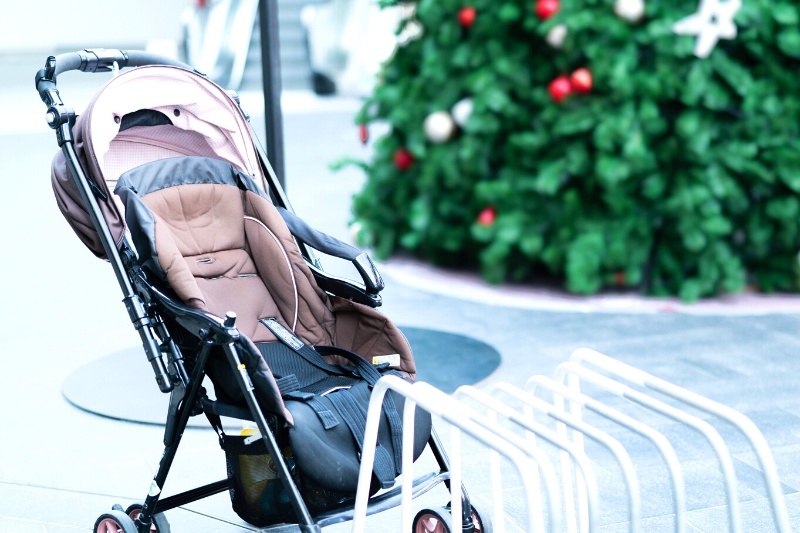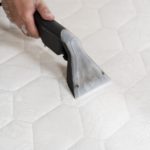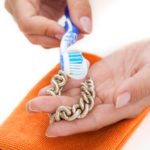Maintaining a hygienic pram is essential to the health and safety of your baby. Thankfully, this can easily be achieved with regular cleaning.
Cleaning not only keeps your pram looking fresh but also prevents the buildup of dirt, bacteria, and other contaminants.
However, with so many different parts of the pram and a combination of materials used in the design, many parents are unaware of how to clean a pram properly.
Fortunately, we have the answers! This guide walks you through the step-by-step process of how to clean a pram effectively.
From the best cleaning solutions to the recommended frequency of cleaning, we’ve got you covered.
What’s the Best Thing to Clean a Pram With?
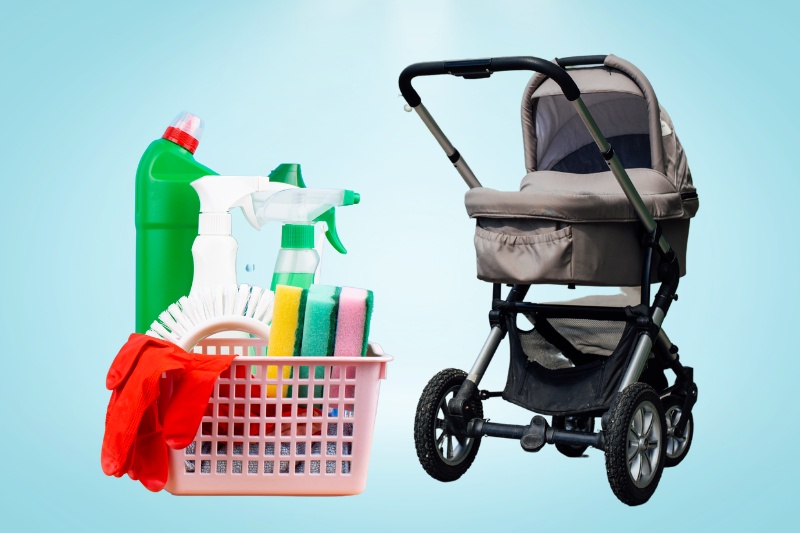
Knowing what cleaner to use on a pram can be complicated. Whatever you clean your pram with should be:
- Effective: Your chosen cleaner must be able to effectively remove all dirt and bacteria from the surfaces of the buggy. This is the only way to ensure proper cleaning and maintain a hygienic space for your little one.
- Versatile: Pushchairs are made from various materials—aluminium or steel for the body frame, fabric for the seat and hood, and rubber or plastic for wheels and handles. Therefore, your chosen cleaner must be suitable for cleaning a wide range of surfaces.
- Gentle: Harsh chemicals or abrasive cleaners may damage the pram, so you must use gentle options to avoid damage. Mild cleaners are also a safer option for your baby. Although all cleaners are washed off the pram as a final step, some residue may be left accidentally.
So, what cleaning solutions tick these non-negotiable criteria? We have three options for you: warm soapy water, vinegar solution, or baby-safe wipes.
1. Warm soapy water
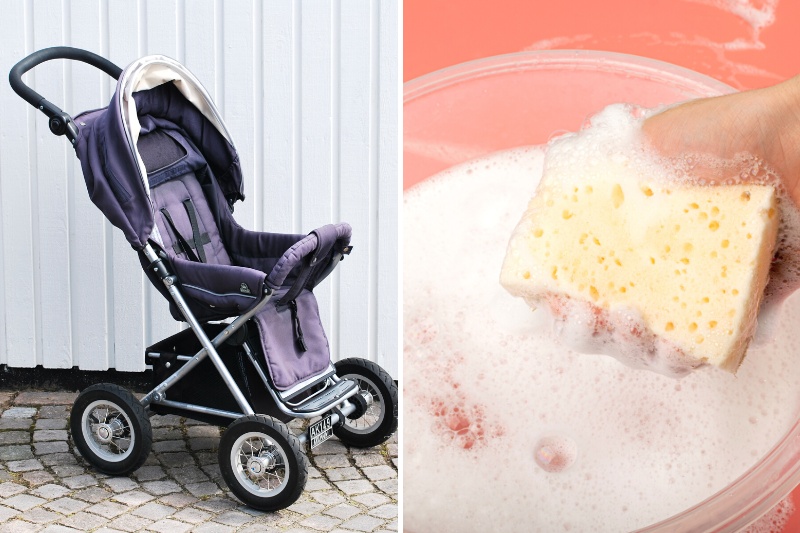
A simple and effective way to clean your pram is by using a solution of mild soap and water. Fill a bucket or basin with warm water, add a small amount of soap, and mix to form a gentle lather.
Dip a soft cloth or sponge into the soapy water and gently wipe the surfaces of the pram to remove any grime and bacteria.
Any mild soap will work for cleaning pushchairs. However, washing up liquid is the most common soap you likely already have in your home.
If using this cleaner, bear in mind that it is gentle—stubborn bits of dirt or tough stains will be better treated with vinegar and water (see below).
2. Vinegar & water solution
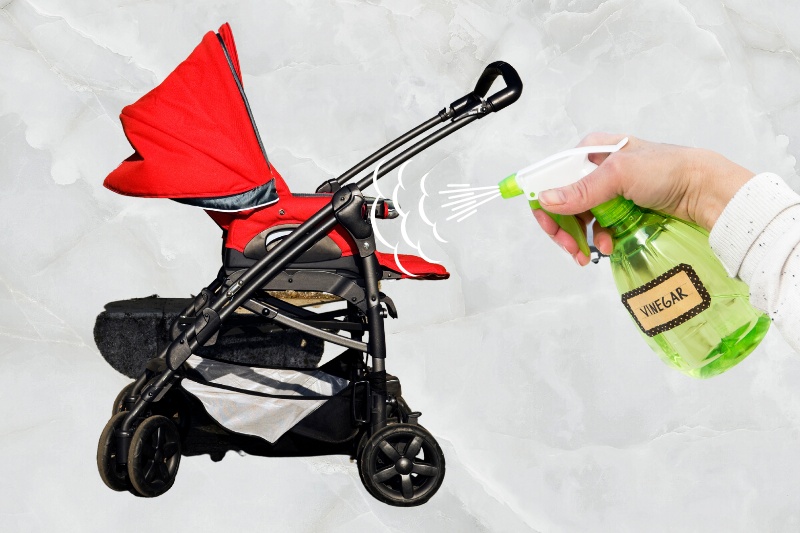
Vinegar is a natural cleaner that effectively reduces bacteria and eliminates odours from your pram.
It’s more powerful than mild soap and is a top option if tackling dirtier buggies.
Create a mixture of equal parts white vinegar and water in a spray bottle. Spray the solution onto the surfaces of the pram and wipe it clean with a cloth or sponge.
Although vinegar is effective in lifting unwanted odours, it doesn’t have a pleasant smell itself. Ensure proper ventilation while using vinegar due to its strong odour.
You could also add a few drops of your favourite essential oil to add a nicer fragrance, though essential oils can be toxic to newborns. It isn’t recommended to use essential oils if your baby is under three months.
3. Baby-safe disinfectant wipes
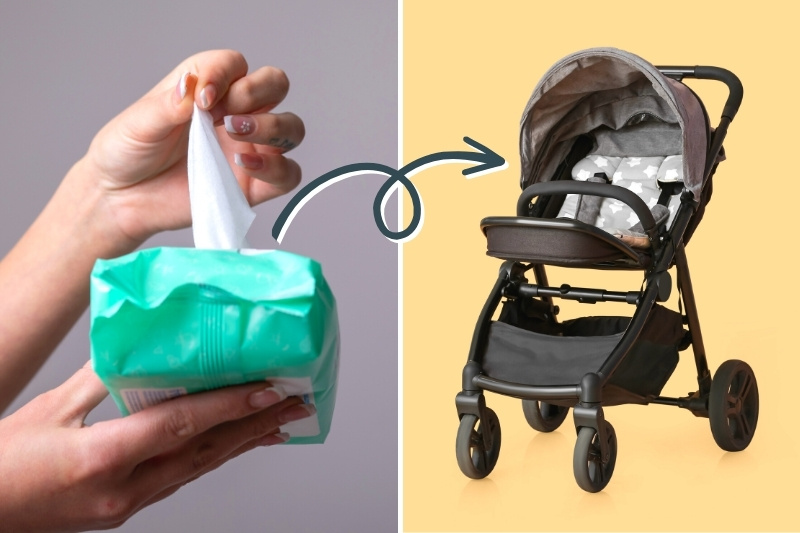
For quick and convenient cleaning, baby-safe disinfectant wipes can be a great option for cleaning your buggy.
Look for wipes specifically designed for baby equipment, ensuring they are alcohol-free and gentle on delicate surfaces. These wipes are ideal for regular maintenance and can be used to wipe down the pram after each outing.
Step-by-Step Guide to Cleaning Your Pram
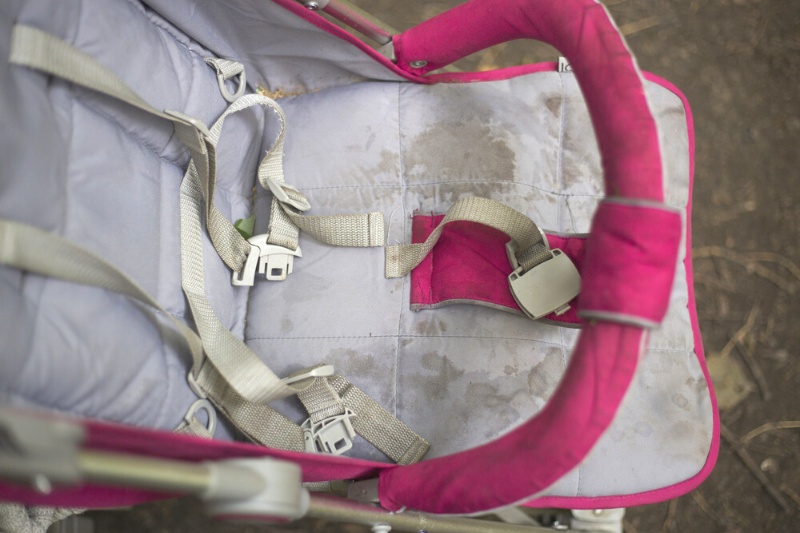
With your cleaner to hand, it’s time to learn how to clean your pram effectively. We’ve broken this down into six easy-to-follow steps, which are listed below.
Before you start, it’s important to ensure your children are not present during the cleaning process.
Even though you’re using gentle cleaners, it’s best to avoid contact with your little one—just to be safe.
We also recommend using minimal amounts of cleaning products and ensuring you properly remove any excess cleaner before use to limit exposure.
With that said, here is our easy six-part method for how to clean a pram:
- Remove debris and dust: Begin by removing any loose debris, dust, or food particles from the pram. This can be done using a soft brush, a handheld vacuum, or simply by shaking out the pram to eliminate the majority of the loose dirt. Removing these loose pieces of dirt now makes the following steps much easier.
- Clean the frame: Dampen a microfibre cloth with your chosen cleaning solution and wipe down the pram frame, paying attention to hinges, joints, and hard-to-reach areas. Frequently touched areas, such as handles and the pram tray, should also receive attention. Ensure you clean thoroughly to remove dirt and grime from the surface.
- Wash the fabric components: Check the manufacturer’s instructions to determine if the fabric components of your pram are machine washable. If they are, remove the fabric pieces and launder them according to the instructions. For non-removable fabric parts, spot clean using the soap and water solution or baby-safe wipes.
- Treat stains: If any stubborn marks on your pram haven’t been removed through the previous steps, these need to be treated separately. Use the 50/50 water and vinegar solution and apply it directly to the stain. Let the solution sit for several minutes before scrubbing thoroughly and rinsing with water.
- Dry: After cleaning, you must allow all pram parts to dry completely before reattaching any fabric components. This helps to prevent the growth of mould or mildew, which could be harmful to your baby. Wipe excess moisture off using a clean, dry cloth and leave fabric parts to air dry.
- Reassemble: Once all parts of the buggy are completely dry, reattach the fabric components and securely assemble the pram according to the manufacturer’s instructions. If you don’t have these, pay close attention to how you dissembled the buggy and retrace your steps in reverse.
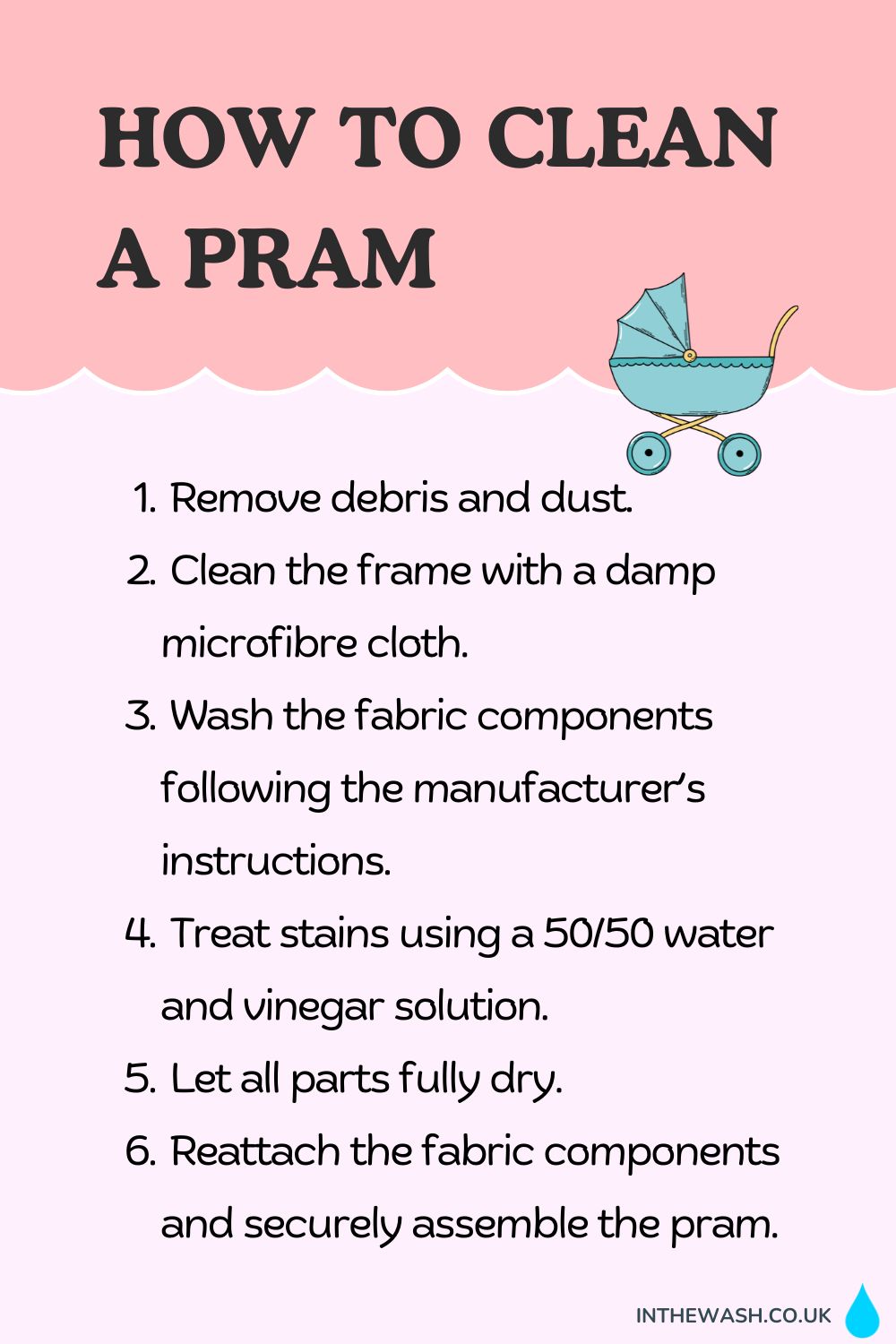
How Often Should a Pram Be Cleaned?

We know that regular pram cleaning offers numerous benefits. It helps maintain a hygienic environment for your baby, prevents the spread of germs and bacteria, and extends the lifespan of your buggy. And that’s not to mention the fact that a clean pram is aesthetically pleasing.
But how often must you clean a pram to get these benefits? The answer to this depends on whom you ask.
However, we recommend basic cleaning every day (or every time you use the pram if it’s not used every day). We then suggest weekly and monthly cleaning to provide a deeper level of cleanliness, tackle stains, and mix any damaged surfaces.
You can discover more about our recommended daily, weekly, and monthly cleaning steps below.
Daily cleaning routine
Cleaning your pram after every use might initially sound like a task that is impossible to maintain. However, it only takes a few minutes and quickly becomes a habit after a few weeks of consistency.
We recommend that you perform a quick wipe down of the pram using baby-safe wipes after each use for ease. If preferred, soapy water or a vinegar solution can be used instead.
Whatever cleaner you use, focus on areas that come into direct contact with your baby such as the handles, tray, and seat for daily cleaning. The remainder of the pram will be tackled later in weekly and monthly cleans.

Weekly cleaning routine
Every week, you should give your pram a more thorough cleaning. You can follow the step-by-step guide mentioned earlier to clean the frame and fabric components on a weekly basis.
However, consistency is crucial, and you must stick to your cleaning schedule. Therefore, you might want to save treating stains for your monthly clean.
Additionally, inspect the wheels whenever you carry out a weekly clean. You should look for debris and remove any hair or tangled threads that may affect their functionality.
These can be pulled away using your fingers or cut away if there are more stubborn knots and tangles.
Monthly deep cleaning
To maintain optimal hygiene, you must dedicate time each month for a deep clean. You can follow the cleaning procedures mentioned earlier for this, but rather than only removing the fabric components, disassemble the pram as much as possible and clean each part individually.
Pay attention to hidden corners, crevices, and hard-to-reach areas where dirt and bacteria can accumulate.
Monthly cleaning is also the best time to spot-treat any stains and tackle issues such as mould or mildew growth.
When scrubbing stains, bear in mind that some of the fabric dye might be lifted. Consider dying the fabric or reupholstering the pram to maintain a perfect aesthetic.
Scratches on the body can also easily be rectified using touch-up paint.
Additional Tips for Pram Maintenance and Hygiene
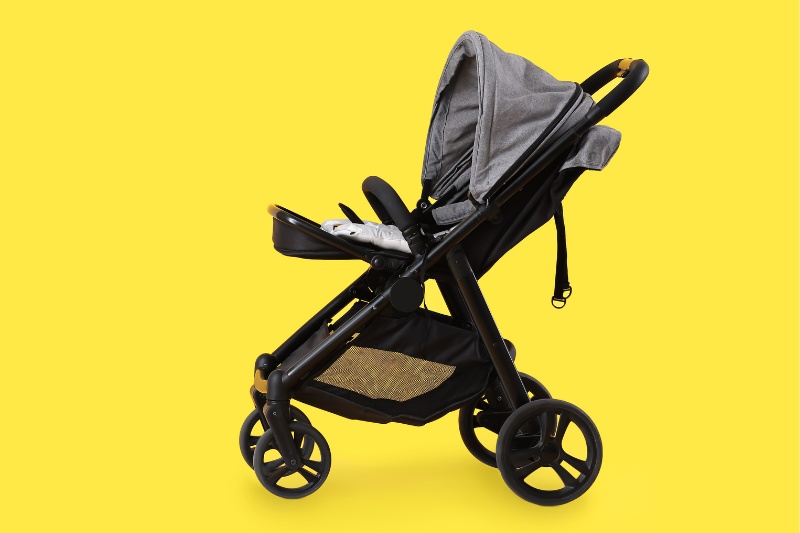
Cleaning your pram regularly on a daily, weekly, and monthly basis is essential for your baby’s health and comfort. However, you can do other important things to limit damage and make each cleaning job easier.
Here are our top tips for optimal pram hygiene and maintenance:
- Store your pram in a clean and dry area to prevent the accumulation of dust and moisture.
- Regularly inspect the wheels and lubricate if necessary to ensure smooth operation.
- Avoid exposing your pram to extreme temperatures, direct sunlight, or excessive moisture.
- Replace worn-out or damaged parts promptly to maintain the functionality of your pram.
- Follow the manufacturer’s instructions and guidelines for specific cleaning recommendations.
- Thoroughly wipe down after beach visits, as sea salt can encourage rust to form.
- Do not leave heavy items in the pram when it’s not in use to limit structural damage.

Hannah has a passion for cleaning. She worked her way around Australia by cleaning hostels in exchange for free accommodation and used her cleaning skills to bag a job as a chalet host for a luxury ski company in France.
